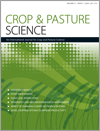CP19315Tactical crop management for improved productivity in winter-dominant rainfall regions: a review
Rainfed climate across the world have always been variable but the variability both within and between seasons has increased. Consequently, crop producers must adjust their management practices at sowing time and during the season to avoid crop failures and to utilise fully the rain that does fall. This review confirms that short-term or in-season decisions are major contributors to yield improvement, but that they need to be further supported by practical research.
CP19315 Abstract | CP19315 Full Text | CP19315PDF (510 KB) Open Access Article





